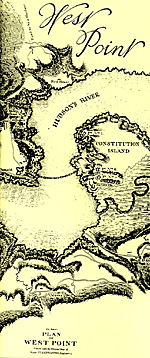 In May 1775, as the Second Continental Congress was
meeting in Philadelphia, word reached anxious members that
Patriot militia under Ethan Allen and Benedict Arnold had seized
Fort Ticonderoga, the wilderness fortress which stood about 225
miles north of New York on Lake Champlain. Upon hearing this
sobering news, American leaders realized that the colonies would
have to face the imminent prospect of war with Great Britain.
In May 1775, as the Second Continental Congress was
meeting in Philadelphia, word reached anxious members that
Patriot militia under Ethan Allen and Benedict Arnold had seized
Fort Ticonderoga, the wilderness fortress which stood about 225
miles north of New York on Lake Champlain. Upon hearing this
sobering news, American leaders realized that the colonies would
have to face the imminent prospect of war with Great Britain.
Almost immediately, the Congress appointed a committee to consider the defense of New York. Chaired by George Washington, the committee believed that the colonists would have to protect and secure the Hudson Highlands which stretched from the Tappan Zee to the tiny river town of Newburgh.
From the experience of the French and Indian War, the American leaders knew that the natural invasion route into the colonies from Canada was Lake Champlain to the Hudson River, and that conversely, the same water corridor was the natural invasion route into Canada from the colonies. Furthermore, the Americans knew that the Highlands controlled the major northeast to southwest land routes of communications which crossed the Hudson from Fishkill to Newburgh on the north and from Verplanck's Point to Stony Point (King's Ferry) at the south. If the British should cut these land routes, they might stop the Americans from moving supplies between New England and the Middle Atlantic colonies and also block the movement of military reinforcements between the colonies. Freedom of movement was particularly important because New England was to provide the bulk of the troops in the war. Loss of the Hudson Highlands, moreover, would isolate the American colonists in upper New York and would leave them at the mercy of the Indians whom the British could more adequately supply and who would consequently become more and more dangerous to the local settlers.
Washington and his committee quickly recommended that the Congress take steps to defend New York. Congress, in turn, sent resolutions to the New York Provincial Convention suggesting that:
- . . . a post be taken in the Highlands, on each side of
the Hudson River, and batteries be erected; and that
experienced persons be immediately sent to examine said
river, in order to discover where it will be most advisable and
proper to obstruct the navigation.
The New York leaders reacted promptly to the Congress' resolution and on the 2nd of June two members of the Convention, Colonel James Clinton and Mr. Christopher Tappen, sailed north to reconnoiter positions to be fortified in the Highlands.
As they sailed up the scenic river, Clinton and Tappen saw several possible sites for fortification in the rugged Highlands-- Stony Point and Verplanck's Point, Anthony's Nose, the banks of Popolopen Creek, Martelaer's Rock, and "the West Point of the Hudson River." What the two men were looking for, however, was a place where both sides of the river could be fortified.
The best choice appeared to be "the West Point," where the river narrows into a S-shaped bend between Martelaer's Rock and the west bank and is buffetted by unpredictable winds and subject to difficult tides. In addition to recommending the emplacement of batteries on "the West Point" and on Martelaer's Rock, Clinton and Tappen urged that a boom be constructed to block the channel to British ships. Surprisingly, they mistakenly recommended that the largest garrison in the area be established on the low ground at Martelaer's Rock which West Point dominates.
Although the New York Provincial Convention accepted the recommendations of Clinton and Tappen and forwarded them to the Continental Congress, it did not order construction begun during the early summer. Only after Washington alarmed the New Yorkers with a report of a possible British raid on New York City, did the Convention take action to fortify the Highlands.
More History of West Point
-
Introduction
1775: Constitution Island
1776: Twin Forts of the Popolopen
1777: Defeat in the Highlands
1778: Fortifications of West Point
1779: Stony Point
1780: Treason
1781-83: Yorktown to Peace
1802: US Military Academy
Back to War Lore: The List
Back to Master Magazine List
© Copyright 2001 by Coalition Web, Inc.
This article appears in MagWeb (Magazine Web) on the Internet World Wide Web.
Other military history articles and gaming articles are available at http://www.magweb.com